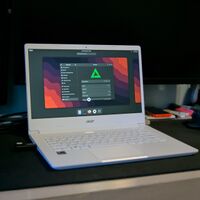Acer Aspire 1 A114-61 (acer-aspire1)
 Aspire 1 running GNOME | |
| Manufacturer | Acer |
|---|---|
| Name | Aspire 1 |
| Codename | acer-aspire1 |
| Released | 2021 |
| Type | laptop |
| Hardware | |
| Chipset | Qualcomm Snapdragon 7c |
| CPU | 2x Kryo 468 Gold + 6x Kryo 468 Silver |
| GPU | Adreno 618 |
| Display | 1920x1080 IPS |
| Storage | 64 GB |
| Memory | 4 GB |
| Architecture | aarch64 |
| Software | |
| Original software | Windows |
| Original version | 10 |
| postmarketOS | |
| Category | testing |
| Pre-built images | no |
| Mainline | yes |
| postmarketOS kernel | mainline |
| Unixbench Whet/Dhry score | 5668.0 |
| Internal storage |
No data |
|---|---|
| SD card |
No data |
| Battery |
Partial |
| Screen |
Works |
| Keyboard |
Works |
| Touchpad |
Works |
| Multimedia | |
| 3D Acceleration |
Works |
| Audio |
No data |
| Camera |
Works |
| Connectivity | |
| WiFi |
Works |
| Bluetooth |
Works |
| Miscellaneous | |
| FDE |
Works |
| USB-A |
Works |
| SATA/eSATA |
No data |
| HDMI/DP |
No data |
| Sensors | |
| Hall Effect |
No data |
Acer Aspire 1 is a low-end Windows on ARM laptop, based on Snapdragon 7c Gen1, a platform that has great mainline Linux support due to some Chromebooks sharing the same platform.
Variant differences
While the most common version of the device seems to be the "WiFi" variant, an "LTE" version with 8GB ram seem to also exist.
Contributors
- travmurav
Users owning this device
- TravMurav (Notes: wifi, A114-61-S45P, daily use)
Installation
Disabling UEFI Secure-Boot
This device uses the standard UEFI secure-boot. The initial configuration seem to contain the keys for some Linux distributors (i.e. Canonical or Debian) but for now it's probably easiest to just disable it.
Note that the following actions may cause Windows to fail decryption if the Bitlocker was enabled.
- Power on the device and press F2 to enter UEFI setup.
- Go to the Security tab and set the maintenance password. Write it down.
- Go to the Boot tab and disable the Secure Boot. This option is only available if the password is set.
- Go back to the Security tab and remove the password by changing it to the empty string.
Installing pmOS on an external storage
You should be able to perform sdcard installation with some usb-stick as the target. Note that the laptop has no SD slot.
Highly consider making a backup of the internal storage, it seems like the recovery media is not available for this laptop.
Installing pmOS on the internal eMMC
| WARNING: The bootloader chain of the device is located in the same eMMC as the OS, damaging internal partition layout may make the laptop into an unrecoverable brick. |
TBD
Known Issues
Work-In-Progress Issues
Kernel package in pmOS follows upstream Linux and only contains the changes that were accepted there.
Here are some differences between pmOS and WIP branch:
| Feature | pmOS | WIP | Notes |
|---|---|---|---|
| Battery | Partial | Works | Battery, lid, USB-C DP Alt mode all need special EC driver, for which only a dity PoC exists at this time. The device will still charge and the led on the side will blink red if there is <10% battery left. |
| Hall Effect/Lid sensor | Broken | Partial | Needs EC. The sensor is reported, but can't be used for wakeup. |
| HDMI/DP | Broken | Works | Implemented in the PoC EC driver. |
| Suspend | Partial | Works | userspace freeze works but extra patches and hacks needed to actually reach low power mode, only available in the WIP branch. |
| Audio | Broken | Partial | Needs work to integrate the audio codec chip, speakers are possible to enable in the WIP branch. |
Other issues
- It's not possible to use virtualization on this device due to the vendor-lock-in.[1]
- The keyboard FN switch in the firmware settings is not effective, the media-keys layer is disabled. (The second layer can be enabled with the EC driver in the future)
See also
References
- ↑ Secure-Launch and vendor lock-in overview: https://github.com/TravMurav/Qcom-Secure-Launch/